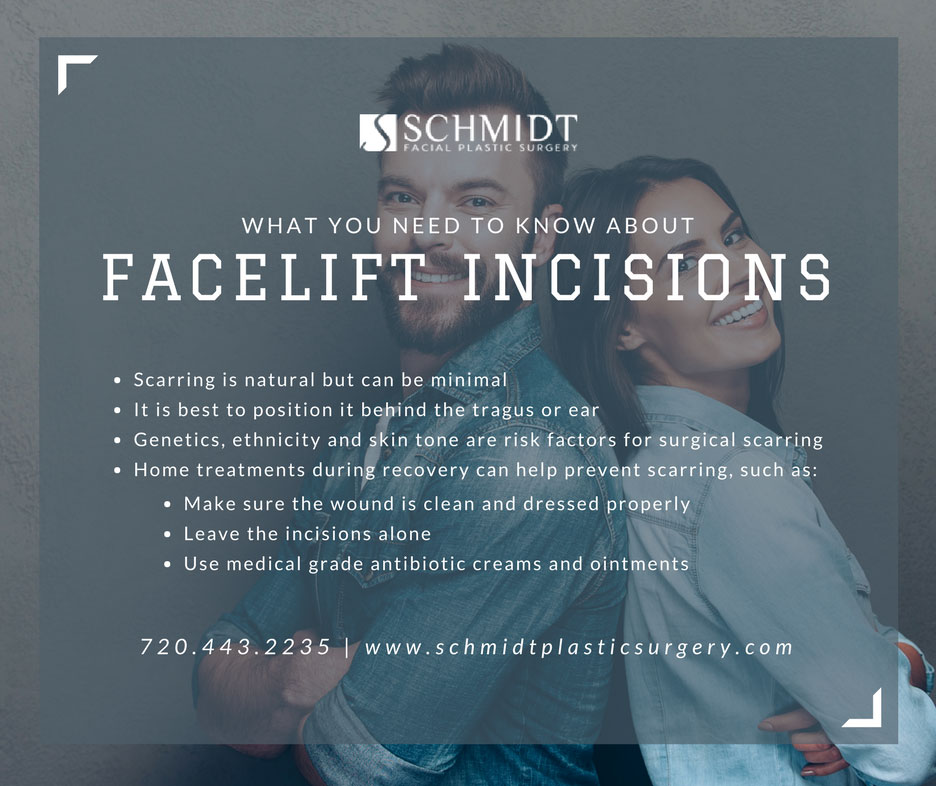When it comes to fighting the effects of aging, facelift surgery is a big weapon at your disposal. Sure, you can go the route of injectables like BOTOX® or dermal fillers to ease wrinkles, lines, and folds – but these are temporary solutions which require multiple treatment sessions and costs can add up over time. At some point, you may want to opt for a more permanent solution. That’s when you should consider cosmetic facial surgery.
Facial surgeries are aesthetic procedures, which turn back the clock on facial aging by softening wrinkles, lines, and folds. Facial cosmetic surgery requires incisions, and with incisions come scars.
Here is some information you should know about facelift scars and how to minimize them effectively:
- Facelift Incisions
- Scars and Why We Get Them
- Incision Placement
- Risk Factors for Surgical Scarring
- At Home Treatment for Facelift Incisions
Facelift Incisions
Most patients who decide on a facelift are hoping to improve their facial appearance. They may have fine lines, jowling, or wrinkles consistent with the aging process. A facelift involves incisions which allow your surgeon to tighten and reposition your facial skin and underlying tissues for a younger, fresher appearance. As with any surgical procedures, a scar is inevitable as this is the body’s natural healing process The ultimate invisibility of the facial scar will depend on location of the incision, skillset of the surgeon, your body’s natural healing response and optimal recovery care.
Scars and Why We Get Them
First, you should not fear a scar because they happen naturally. Scars result when fibrous tissues close an open wound. When a wound is small, or an effort was made to help it heal, scarring can be minimal. But when a wound is too big or wide, the scar usually remains. Also, if the underlying tissue is damaged, scars may be more prominentor unsightly.
No matter what they promise, even the best plastic surgeon cannot prevent scarring completely. However, by utilizing surgical techniques, Dr. Schmidt strive to make any potential scars as inconspicuous as possible.
Optimal placement and creating a small incision is a key component to avoid visible facial scarring.
Incision Placement
The most important factor in hiding facelift incisions is proper placement. For a inconspicuous facelift scar, it is best to position the incision behind the tragus (protruding from the inner ear), or the ear altogether. To place the incision in front of the ear will cause a prominent line no matter how well it heals. Carefully placed incisions within natural facial boundaries, natural anatomical folds or lines, or within the hairline are also optimal incision locations to avoid visible scarring. The goal is to make these incisions nearly invisible after they heal so you can enjoy your results..
Risk Factors for Surgical Scarring
Genetics is a key factor in how your body will scar. Ethnicity and skin tone can also be a factor as certain races have a higher potential for scarring than others. Individuals with a darker skin tone, particularly African-Americans, have higher risks for keloid and hypertrophic scars.
Age also plays a significant role in potential scarring. As we age, our skin becomes less flexible and thinner. Also, it has been exposed to environmental factors longer, which slows the skin’s healing process.
These are topics to discuss with Dr. Schmidt during your consultation. They are aware of the risk factors and can advise the best course to take for successful surgical outcomes.
At Home Treatment for Facelift Incisions
After your facelift, home treatments from Dr. Schmidt’s recovery instructions are critical for incision healing and scar prevention. These are the first steps you can take personally for avoiding unsightly scars. Here are some scar prevention tips to follow at home:
- Make sure the wound is clean and dressed properly – You will receive instructions on when and how often to remove dressings and clean the incisions.
- Leave the incisions alone – Other than cleaning; you should never mess with the incision by picking or scratching at the scabs. These actions increase the chance for improper healing and additional complications.
- Use medical grade antibiotic creams and ointments – Dr. Schmidt may prescribe some creams to apply to the wound to aid in its healing.
After your incision heals completely, a scar may be left behind. There are some things you can do now to reduce their visibility.
- Massage – Massaging your scar will help flatten and soften it. It will break up the scar tissue and help manage pain and itching during healing. Your surgeon will provide you with instructions for proper methods and when to start.
- Topical silicone gel sheeting – BioCorneum is a topical silicone based adhesive that helps with thereduction of keloid and hypertrophic scarring. They’re easy to use, just apply to the affected area.
- Moisturize – Well hydrated skin heals properly. Using moisturizing skin care products that Dr. Schmidtn recommends will go a long way in preventing unsightly scars.
- Hydrate – You should drink plenty of water for proper hydration during recovery. This will ensure your skin will get proper moisture, which is key to successful healing and avoiding visible scars.
- Use sunscreen – UV rays will darken any scarring, so it is important to use sunscreen religiously. Colorado has over 300 days of sunshine a year, you may experience more sun exposure during your daily routine then you realize. Whether you’re on the slopes, hiking the trails, or enjoying a patio, use sunscreen and/or other UV protection.




